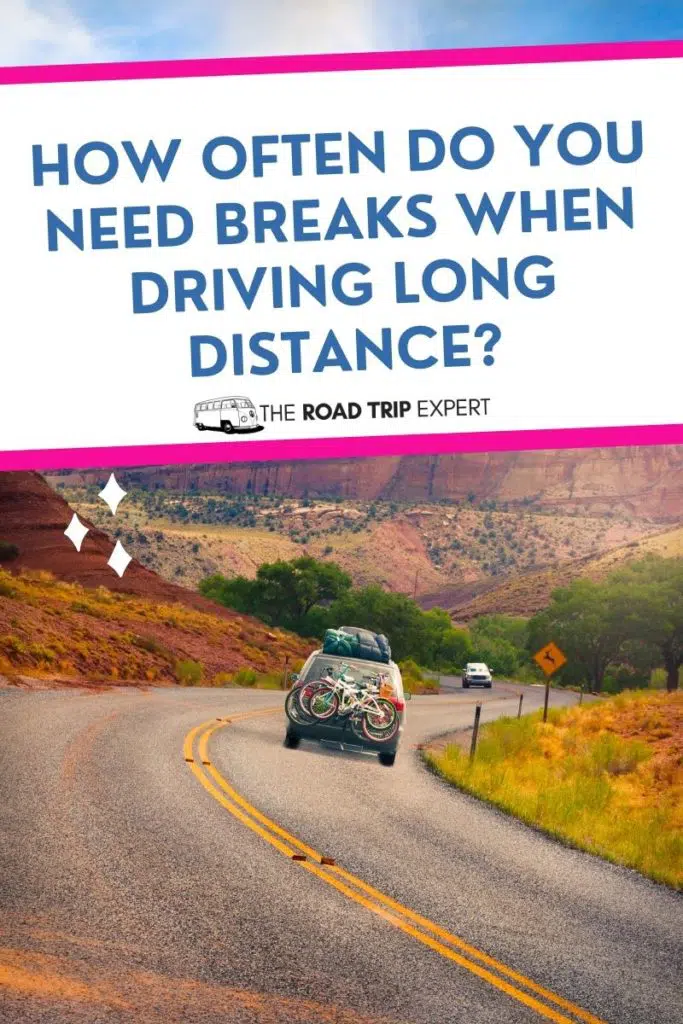When driving long distances you should take a break every two hours for at least 15 minutes. Stop to rest frequently for a total of at least 45 minutes per 4.5 hours of driving to prevent fatigue and increase alertness. Plan to visit rest stops every 100 miles during your long road trip to enjoy a comfortable drive. Try to limit driving to 9 hours per day.
When driving for an extended period of time you should make sure you stop for at least one longer break lasting a minimum of 30 minutes in order to be properly rested. Driving long distances whilst tired has a number of risks which are outlined in this article.
We will also discuss fun things you can do at rest stops and other tips related to taking breaks on road trips.
Affiliate Disclosure: Thank you for supporting The Road Trip Expert. When you purchase through links on this site, we may earn an affiliate commission. Please see our advertising disclosure for more details.
How long should you drive per day on a road trip?
You should drive for a maximum of 9 hours per day on a road trip to prevent the risks associated with driving too long. If you have multiple drivers you can extend this to 12 hours however you may not enjoy the journey if you are on the road for the entire day. Plan to drive for 8 hours or less whenever possible.
If you are going on a road trip for a vacation, I would try to keep the average driving per day to 4 hours or less in order to have a balance between seeing a lot of places and not spending too much time in the car. This is one of my main tips for planning the perfect road trip.
From my experience, if you are stopping at fun places, driving for longer than 9 hours can leave you feeling tired and not enjoying the road trip. Taking your time also allows you to stop off at unexpected attractions along your route!
How long should you take a break for on a road trip?
The length of your break on a road trip should be a minimum of 15 minutes for every two hours of driving. You should also include a long break of at least 30 minutes if you plan to drive long distances over several hours. Frequent rest stops allow you to stretch your legs, refuel, use the restroom, and pick up snacks.
If you plan to drive for over 8 hours it’s a good idea to incorporate at least one 30-minute stop halfway through the day where you do something to boost morale. This could be a short walk or visiting a roadside attraction. If you need some additional ideas, we have a post outlining lots of fun things to do during your road trip.
How often should you stretch on a road trip?
You should get out of the car and stretch on a road trip every two hours for at least 5 minutes to get your body moving and prevent lower back pain. Rest stops are excellent places to walk, stretch, and move your entire body in order to promote blood circulation and release your body from its fixed driving position.
Keep in mind, if you are traveling with pets or small children they will need more frequent stretch breaks. Brisk walking, star jumps, and touching your toes are all great options!
If you suffer from back problems when driving long distances, you could consider this lumbar support for your car seat available on Amazon.
How often should you stop for gas on a road trip?
You should stop for gas on a road trip every three hours to refuel and stretch your legs. It’s a good idea to plan your route to incorporate these stops, as well as map out where the cheapest gas stations are. This ensures you do not run out of fuel and provides the flexibility to take a detour if a fun opportunity arises.
You should take advantage of cheap gas prices along your route to prevent you from having to pay more than usual to fill up the tank. A good tip is to stop for lunch somewhere off the highway, where prices tend to be lower. Check out our guide on estimating the cost of gas for a road trip if you want to know more.
How often should you stop on a road trip?
Official advice says that you should stop every 2 hours for at least 15 minutes while on a road trip. It may seem excessive, however, frequent short stops mean you are less likely to experience driver fatigue. Planning to visit multiple rest stops ahead of time causes less disruption to your long car journey, which means less time wasted.
How long can I legally drive without a break?
While professional drivers have limits to how long they can drive without a break, there doesn’t appear to be an official law for private citizens just living their best road trip lives. It is recommended that you stop for 15 minutes every 2-3 hours and do not exceed 8 hours of driving in a day to prevent driver fatigue.
5 Things to do whilst on a break during a long drive

Stops don’t just mean rolling through a gas station, using the restroom, and hopping back in the car. They can be a great opportunity to recharge your batteries and make the journey part of the adventure.
1. Stop in a rural area for a picnic.
Check your route for nature reserves, state or national parks and incorporate it into one of your scheduled stops. Make sure not to eat a large meal as this can cause fatigue and discomfort when you get back on the road.
2. Famous truck stops are a great place to grab a quick coffee and pick up a few souvenirs.
Take 15 minutes to try on some funky sunglasses, pick up a touristy treasure, and use the restroom. Don’t forget to do some stretches to get the blood flowing and reduce the risk of lower back pain!
3. There are all kinds of weird and wonderful roadside attractions to see.
Take the time to google what is in the area when you are planning your route. Having mini destinations before reaching your actual destination is a great way to incorporate breaks without feeling like you are losing time.
4. Nature reserves, beaches, and state/national parks are great places to get out and take a short hike.
We can be tempted to get out of the car and go sit in a café/restaurant, but it’s much better to get some fresh air and stretch those legs.
5. Play a game
If you are alone, bring along a deck of cards, sudoku, or some word puzzles to get your brain moving (avoid using a screen for this). If you’ve got company, bring a ball to throw or kick around, or a favorite board game to have a quick round at the picnic tables. Anything that gets the brain fired up and the endorphins going.
5 Reasons to stop more often on a road trip

It is officially recommended that you stop every 2-3 hours for a short period of time, but each person’s situation is unique. Know yourself, and know your passengers, and plan accordingly.
1. If you have a medical condition, be aware of your body and its limitations.
Take as many stops as you need to allow your body time to recover or stretch. Be aware of what medications you are taking, when you take them, and how they will affect your ability to drive safely.
2. Traveling with young children or pets changes everything as they won’t be able to sit in the car as long as you can.
Plan plenty of potty breaks and schedule stops in more interesting places so that children and pets can get out and burn some energy. Be aware that gas stations, while great places to stop for a potty break, are not the safest places for kids and pets to run around. Find places like information centers, national parks, or roadside attractions.
3. If you will be driving 8+ hours a day, several days in a row, know that tiredness can stack up as the hours and days go by.
Schedule your driving time with official start and stop times and keep to the official advice of frequent shortstops.
4. Allow for adverse weather conditions by stopping when it becomes too dangerous to keep driving.
Driving in extreme wind, rain or snow can be a serious hazard, so pull over and make sure your car is fit to drive (check fuel, add chains if necessary) and double-check your emergency supplies. Check your weather app and see if there is a better weather window before getting back on the road.
5. The NHTSA recommends avoiding driving during peak tired times, between midnight and 6 am or the late afternoon.
If you must drive in these windows, plan for more frequent stops to keep you alert and be ready to admit when you have reached your limit.
5 Risks of driving long distances with no breaks

The National Highway Traffic Safety Administration estimates that there are 56,000 sleep-related accidents in the USA annually. Driving drowsy increases your reaction time and decreases your ability to detect and process information. It’s incredibly important that you get adequate sleep between driving sessions and take necessary breaks to refuel and recharge.
1. The number one risk of driving without breaks is falling asleep at the wheel.
As mile after mile goes by, listening to the steady background car noises, watching the night slowly creep in, your environment tells your brain it’s time to go to sleep. Falling asleep at the wheel is a fatal risk to yourself and others on the road, it just isn’t worth it.
2. As you become more tired and settled into a driving routine, your ability to detect and interpret threats seriously decreases, and your reaction time increases.
Breaks keep our minds awake, alert, and engaged. If you skip breaks, you increase your risk of becoming idle, or drowsy, behind the wheel.
3. Negatively affects your mental health
Spending long hours in the car, especially if you are on your own, can leave you feeling depressed and a little lonely. Fresh air, a short walk, and a little silence can boost morale.
4. Spending endless hours sitting in the car isn’t great for your body.
Your back, joints, and circulation can all take a serious beating if the hours go by without any respite from the road. Make sure your breaks include ample time to stretch and get the blood flowing again.
5. Running out of fuel is a serious risk that can leave you in a dangerous situation.
You may be feeling so great, alert, and ready for the road, that you don’t even notice the miles are going by, and the gas is going down. Suddenly, your car is slowing to a stop 30 miles from the nearest gas station and it’s dark out. Regular stops mean you are constantly topping up on fuel and much less likely to be caught off guard.
NHTSA Tips for Alert Driving

- Make sure you are getting plenty of quality sleep between driving sessions.
- Avoid alcohol consumption as much as possible as this can disrupt sleep and affect your driving the following day.
- Know what medications you are on and how they affect you.
- Avoid driving during peak tired times, specifically, midnight-6 am and late afternoon, whenever possible.
Here are some tips from the NHTSA for alert driving.
Related Questions
What happens if you drive for too long?
If you drive for too long without breaks you are vulnerable to driver fatigue. This means your ability to detect and interpret threats is compromised and your reaction time increases. You become more likely to have an accident, make mistakes, or forget to refuel. It can also take a toll on your mental and physical health.
How long should you drive before taking a break?
Official advice recommends a healthy, solo driver stops every 2-3 hours for a short break. If you have young children or pets in the car, it is important to consider their needs and stop more frequently for bathroom and exercise breaks. You’ll want to consider any medical conditions you or your passengers may have when planning your breaks.
How often should you take a break when driving long distances?
Take a 15-minute break every 2-3 hours and avoid driving more than 8 hours a day. Frequent stops dramatically improve safety by reducing the risks of driver fatigue and maintaining vehicle integrity. If planned properly in advance, they shouldn’t disrupt your journey or add more than an hour to your journey.
Disclosure: Some of the links in this article may be affiliate links. This means I earn a commission if you make a qualifying purchase, but this is at no additional cost to you. Thank you for supporting The Road Trip Expert.




